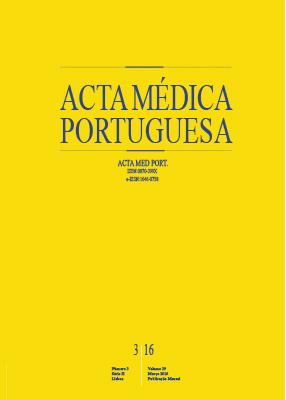Twenty Years of Autologous Stem Cell Transplantation in Diffuse Large B-Cell Lymphoma: A Single Portuguese Center Experience
DOI:
https://doi.org/10.20344/amp.6617Keywords:
Hematopoietic Stem Cell Transplantation, Lymphoma, Large B-Cell, Diffuse, Transplantation, Autologous.Abstract
Introduction: Diffuse large B-cell lymphoma can be cured in 60% – 70% of patients. Autologous stem cell transplantation is the standard treatment for relapsed disease. This high-intensity treatment after first complete remission in patients with high International Prognostic Index remains controversial and was performed in our department during some years.
Material and Methods: Retrospective study, review of clinical records.
Results: This study evaluates the outcome of 113 patients transplanted between 1992 and 2012. Considering status before transplantation patients were divided in groups: a) first complete remission after 1 line of chemotherapy (n = 64); b) first complete remission after ≥ two chemotherapy lines (n = 15); c) second complete remission (n = 15); d) more advanced diseased (n = 19). Chemotherapy used in first line therapy was mainly R-CHOP (n = 71) and CHOP (n = 28). The median follow-up of patients still alive was 34 months (1 - 221). At five years, overall survival was 73% (± 5) and disease free survival was 75% (± 5).
Conclusion: Conventional chemotherapy followed by autologous stem cell transplant is a safe and efficient option for selected patients. In our series 70% high-risk patients were free from disease with this strategy.
Downloads
Downloads
Published
How to Cite
Issue
Section
License
All the articles published in the AMP are open access and comply with the requirements of funding agencies or academic institutions. The AMP is governed by the terms of the Creative Commons ‘Attribution – Non-Commercial Use - (CC-BY-NC)’ license, regarding the use by third parties.
It is the author’s responsibility to obtain approval for the reproduction of figures, tables, etc. from other publications.
Upon acceptance of an article for publication, the authors will be asked to complete the ICMJE “Copyright Liability and Copyright Sharing Statement “(http://www.actamedicaportuguesa.com/info/AMP-NormasPublicacao.pdf) and the “Declaration of Potential Conflicts of Interest” (http:// www.icmje.org/conflicts-of-interest). An e-mail will be sent to the corresponding author to acknowledge receipt of the manuscript.
After publication, the authors are authorised to make their articles available in repositories of their institutions of origin, as long as they always mention where they were published and according to the Creative Commons license.









